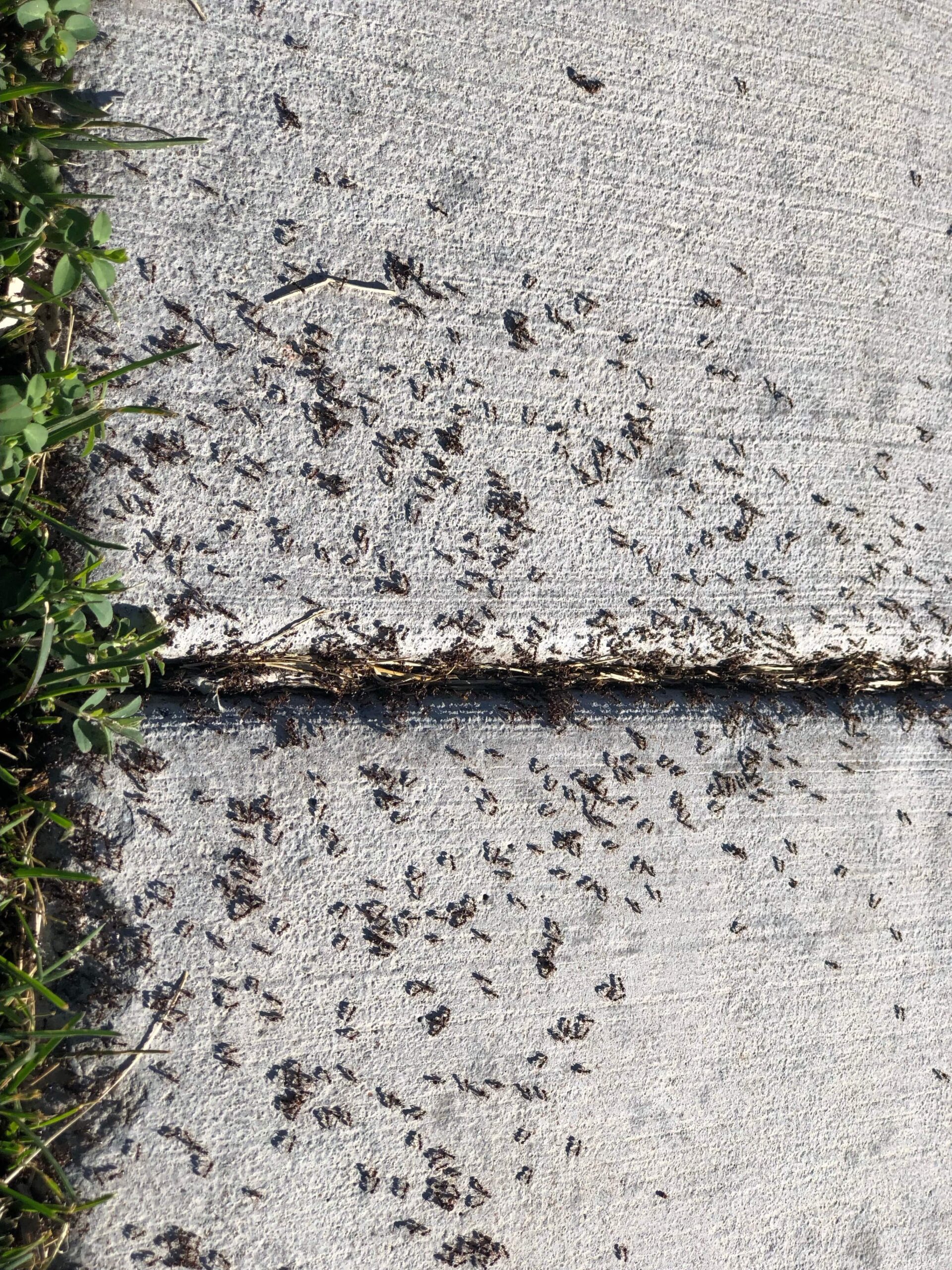
July 2025, Payson UT
Courtesy & Copyright Lyle W. Bingham, Photographer
I’m an avid runner and walker. And my town has done a lot of street and sidewalk work this year, so I’ve spent a lot of time looking down to make sure I don’t suddenly trip or step in a hole. Earlier this year, I was looking down while walking to my office, and I was amazed by how many ant colonies I was seeing on the sidewalks. Each colony included hundreds of tiny ants, milling around in what looked like random patterns. Some blocks had an ant swarm every 20 to 30 feet.
I’d seen them before, of course, but hadn’t realized just how ubiquitous they are. Being a scientist and therefore endlessly curious, I began to wonder: What are these ants doing when they swarm? And how do they all know to do it at the same time?

July 2025, Payson UT
Courtesy & Copyright Lyle W. Bingham, Photographer
As I watched closely, I realized that the ants’ movements weren’t entirely random. They would approach another ant, stop for a half second, then move on. That’s because one purpose of swarming is colony expansion. They wander around checking each other out. If an interloper from another colony enters the swarm and is recognized as a stranger, it will be attacked. Sometimes hundreds of ants can die in battles between neighboring colonies.
The other thing that happens when they’re swarming is mating. Some of the ants develop wings and take nuptial flights, when males and queens from different colonies take to the air and mate. They like to do this on clear, warm surfaces, when the days are long and hot sunlight has warmed the soil for a while. If each colony responds to the same environmental cue, it means there is a huge pool of prospective mates, which increases genetic diversity and colony success.
After mating, the males die and the queens, which are about twice as big as the other ants, fly off to start new colonies. Worker ants from nearby colonies will collect and remove the dead ants quickly. This helps prevent predators from being able to locate the colonies, which spend most of their time in nests beneath flat stones or similar hard spaces – such as sidewalks. Within a week after the swarms appear, they’re gone.
Pavement ants can be a nuisance if they get into your pantry. But when they’re swarming safely out on the sidewalk, they’re just a fascinating part of nature – one that most of us can observe without going more than a block or two from home.
I’m Mark Brunson, and I’m wild about Utah’s natural creatures, wherever they’re found.
Credits:
Images Courtesy & Copyright Lyle Bingham, Photographer, Bridgerland Audubon Society
Featured Audio: Courtesy & © Kevin Colver, https://wildstore.wildsanctuary.com/collections/special-collections and Anderson, Howe and Wakeman
Text: Mark Brunson, https://www.usu.edu/experts/profile/mark-brunson/
Additional Reading: Mark Brunson, https://www.usu.edu/experts/profile/mark-brunson/ & Lyle Bingham, Bridgerland Audubon Society
Additional Reading
Mark Brunson’s archive: https://wildaboututah.org/?s=brunson
Pavement Ants, Hillman Ball Park, Payson UT, After the Sprinklers
Courtesy & Copyright Lyle W. Bingham, Photographer
Tetramorium caespitum – Bugwoodwiki
https://wiki.bugwood.org/Tetramorium_caespitum
Tetramorium caespitum – iNaturalist
https://www.inaturalist.org/guide_taxa/832327
Immigrant Pavement Ant (Tetramorium immigrans) – iNaturalist
https://www.inaturalist.org/taxa/569552-Tetramorium-immigrans
Pavement Ant | NC State Extension Publications
https://content.ces.ncsu.edu/pavement-ant
“Pavement ants (Formicidae, Tetramorium immigrans) are northern Utah’s most common pest ant in and around homes and structures. Until recently, the pavement ant’s scientific name was Tetramorium caespitum, but recent genetic work has clarified that our common pest Tetramorium species in the U.S. is from Europe and has been given the name T. immigrans (Wagner et al., 2017; Zhang et al., 2019). Genetic variation among pavement ant populations in the U.S. is low and it is believed that current populations were derived from one or a few closely related colonies from Europe introduced into the northeastern U.S. about 200 years ago (Wagner et al., 2017; Zhang et al., 2019).”
Pavement Ants, Extension, Utah State University (USU), https://extension.usu.edu/planthealth/research/pavement-ants
When the Ants Come Marching In…, IPM Fact Sheet #8, USU Extension, Utah State University, https://extension.usu.edu/planthealth/schoolipm/files/pest-press-fact-sheets/pdf/ants_pestpress.pdf
Pavement Ant, Tetramorium caespitum | USU
https://extension.usu.edu/planthealth/ipm/notes_ag/hemp-pavement-ants



